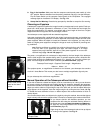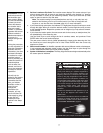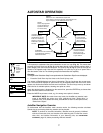
15
Manual Operation of the Telescope Using AutoStar's Arrow Keys
You may also observe land and astronomical objects using AutoStar's Arrow keys.
If you have not already done so, prepare your telescope following the steps described in
TELESCOPE ASSEMBLY, page 13. Next, flip the On/Off Switch (C, Fig. 1b) on the computer con-
trol panel to the ON
position. The copyright message lights on AutoStar’s display. Press the
Speed/? key (
7, Fig. 5) to accept the Sun warning. The "Getting Started" message displays.
Keep pressing the ENTER key until "Country/State" appears on the display.(Ignore the prompts
requesting "Date" and "Time" for now – these functions will be explained later in the manual).
Use the Scroll keys to cycle through the database of countries/states. Press ENTER when your
location displays. Next, use the Scroll keys to scroll to the nearest city to your observing site
and press ENTER.
Next, use the Scroll keys to scroll to your telescope model and press
ENTER. The display then reads "Setup: Align."
You can now use the Arrow keys (
5, Fig. 5) to slew (move) the telescope up, down, right, or left.
To change the telescope’s slew speed, briefly press the Speed/? key (
7, Fig. 5). Each press
decreases the sle
w speed down one level, and then cycles back to the fastest speed. See page
15 for more information.
Tighten (to a "firm feel" only, do not overtighten) the vertical and horizontal locks (
13 and 14,
Fig. 1
). Sight along the side of the telescope’s main tube to locate an object and practice using
the A
utoStar’s Arrow keys to center the object in the telescope’s field of view. Use the tele-
scope’s focus knob (
15, Fig. 1) to bring the object into focus.
This procedure demonstrates just a very small part of AutoStar's capabilities. In the next section
of this manual, you will begin to learn how to make use of AutoStar's extensive and powerful fea-
tures.
Slew Speeds
AutoStar has nine slew speeds that are directly proportional to the sidereal rate (this is the
speed at which stars move) and have been calculated to accomplish specific functions.
Pressing the SPEED/? key changes the slew speed, which is then shown for about two
seconds on AutoStar’s display.
The nine available speeds are:
{ Speed 1 = 2x = 2 x sidereal (0.5 arc-min/sec or 0.008°/sec)
{ Speed 2 = 8x = 8 x sidereal (2 arc-min/sec or 0.033°/sec)
{ Speed 3 = 16x = 16 x sidereal (4 arc-min/sec or 0.067°/sec)
{ Speed 4 = 32x = 32 x sidereal (8 arc-min/sec or 0.13°/sec)
{ Speed 5 = 64x = 64 x sidereal (16 arc-min/sec or 0.27°/sec)
{ Speed 6 = 0.5° = 120 x sidereal (30 arc-min/sec or 0.5°/sec)
{ Speed 7 = 1°/s = 240 x sidereal (60 arc-min/sec or 1°/sec)
{ Speed 8 = 2°/s = 480 x sidereal (120 arc-min/sec or 2°/sec)
{ Speed 9 = Max = (Maximum speed possible, dependent on battery power)
Speeds 1,
2,
or 3:
Best used f
or fine center
ing of an object in the field of vie
w of a higher po
wer
e
yepiece, such as a 12mm or a 9mm eyepiece.
Speeds 4, 5, or 6: Enables centering an object in the field of a low-to-moderate power eye-
piece
, such as a standard 25mm eyepiece.
Speeds 7 or 8: Best used f
or rough center
ing of an object in the e
yepiece.
Speed 9: Moves the telescope quickly from one point in the sky to another.


















